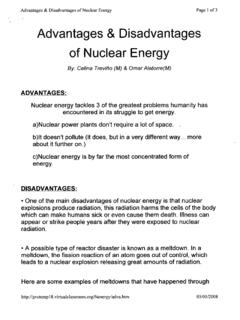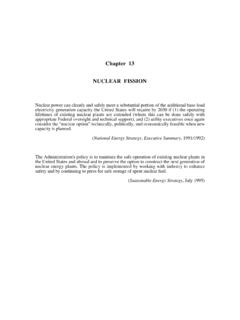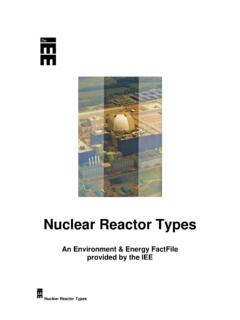Chernobyl Nuclear
Found 9 free book(s)The Chernobyl Reactor: Design Features and Reasons for ...
www.rri.kyoto-u.ac.jpChernobyl accident exists. The power of it could be equivalent to 200 tons of the trinitrotoluene (TNT). Introduction The accident at Unit 4 of the Chernobyl Nuclear Power Plant (NPP) on 26 April 1986 is the most severe accident in the history of the peaceful use of the nuclear energy. As a …
Advantages Disadvantages of Nuclear Energy - NRC: Home …
www.nrc.govMay 01, 2008 · cooling system of a nuclear reactor failed. Radiation escaped, forcing tens of thousands of people to run away. Fortunately the problem was solved minutes before a total meltdown would have occurred, and there were no deaths.-In 1986, a much worse disaster hit Russia's Chernobyl nuclear power plant.
CHAPTER 23 NUCLEAR CHEMISTRY - Glendale Community …
web.gccaz.eduPrimary problems with nuclear power plants: 1) safety (Chernobyl and Three Mile Island had cooling system failures that led to reactor meltdowns. Chernobyl also did not have containment building around reactor.) 2) nuclear waste - some products will …
BENEFITS OF NUCLEAR - ecolo
www.ecolo.orgSafe: Nuclear power is safe, as proven by the record of half a century of commercial operation, with the accumulated experience of more than 12,000 reactor-years. There have been only two serious accidents in the commercial exploitation of nuclear power: Three Mile Island in 1979 (in Pennsylvania, USA) and Chernobyl in 1986 (in
INSAG-7 The Chernobyl Accident - IAEA
www-pub.iaea.orging on the Chernobyl Accident (held in Vienna from 25 to 29 August 1986) bears on general issues of the operational safety of nuclear power plants in the then Union of Soviet Socialist Republics as well as on specific issues relating to the design of the Chernobyl type light water cooled, graphite moderated RBMK reactors.
What is Nuclear Energy? - Nuclear Regulatory Commission
www.nrc.govNuclear power plants also create radiation from the fuel they use and the process of creating electricity. ... A much more serious accident happened in 1986 at Chernobyl in the former Soviet Union. That accident released a large amount of radioactivity into the environment. That reactor was very different from
Chapter 13 NUCLEAR FISSION - Pennsylvania State University
personal.ems.psu.edufossil fuels and the nuclear reactions of fission of radioactive isotopes. We show that the origin of society's interest in nuclear energy lies in the fact that much more energy is released per unit mass of a nuclear fuel than per unit mass of a fossil fuel. This is a mixed blessing. It has led to the development of nuclear weapons (see Chapter ...
Nuclear Energy the Good the Bad and the Debatable
www.niehs.nih.govNuclear energy is produced when an atom's nucleus is split into smaller nuclei by the process called fission. The fission of large atoms, such as Uranium 235 and Plutonium 239, produces a ... and the one at Chernobyl in the former Soviet Union, many people are opposed to Nuclear Power. Also, environmentalists, as well as other
Nuclear Reactor Types - Stanford University
large.stanford.edufated Chernobyl plant. The layout consists of a large graphite core containing some 1700 vertical channels, each containing enriched uranium dioxide fuel (1.8% U235). Heat is removed from the fuel by pumping water under pressure up through the channels where it is allowed to boil, to steam drums, thence driving electrical turbo-generators.








